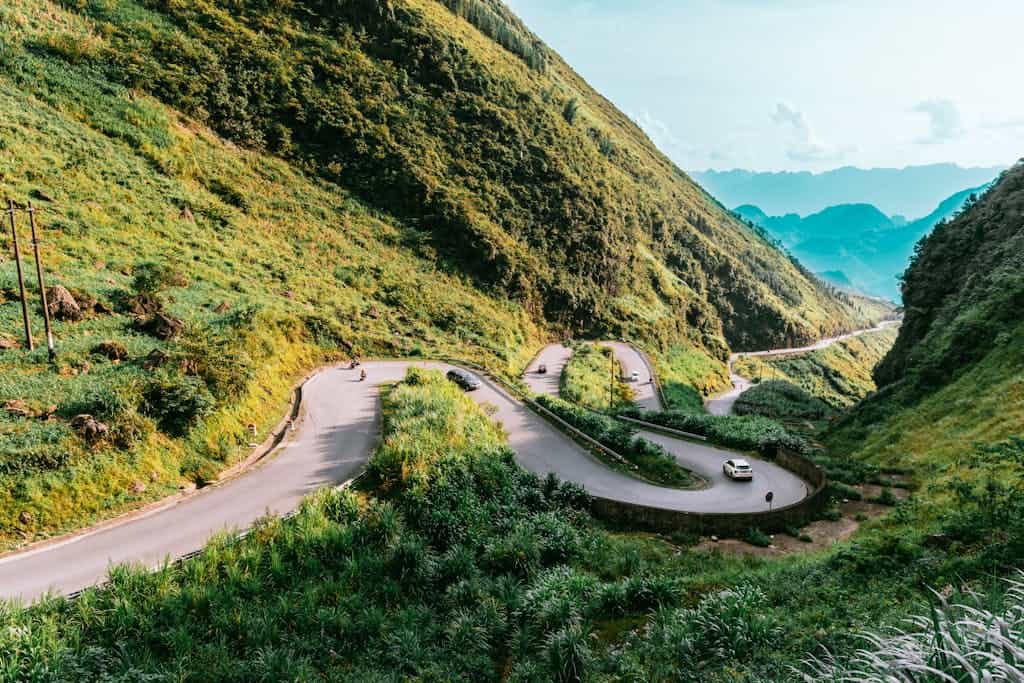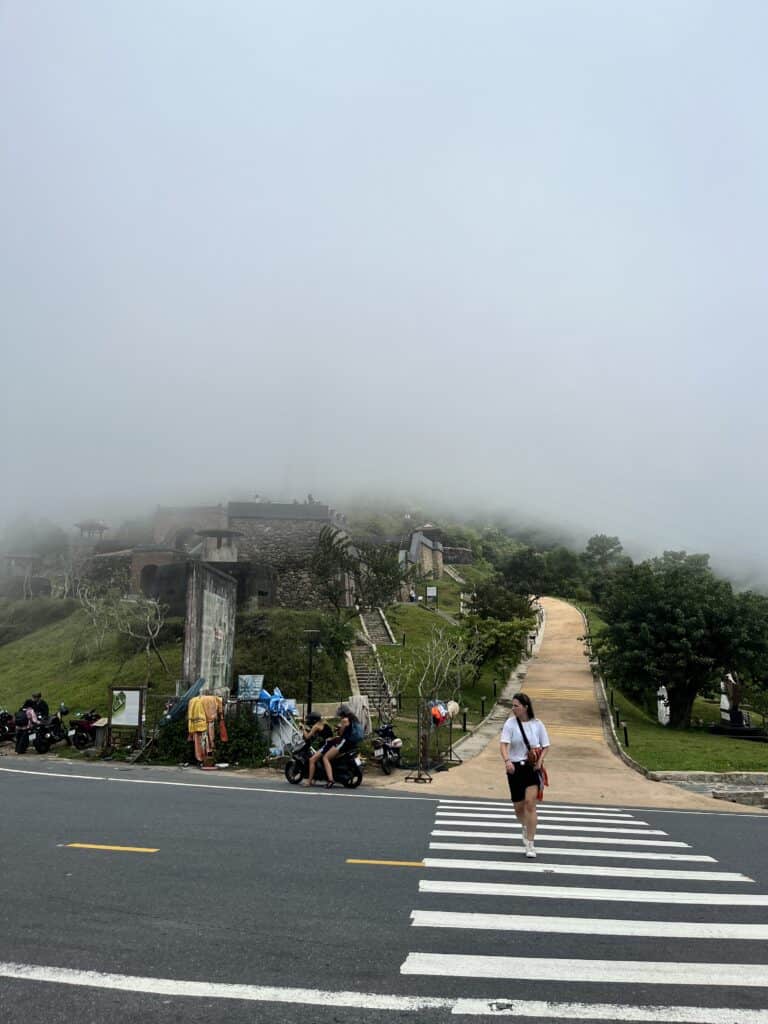Most travelers treat the road between Da Nang and Hue as a mere transfer – a necessary few hours between two of Vietnam’s most interesting cities. But the truth is: this short stretch of coast offers some of the most scenic views in the country, if you do it right.
I took this route by private car with four friends, turning what could’ve been a two-hour drive into a leisurely day of stops, snacks, and scenic viewpoints. But I almost chose the train. And the motorbike route over Hai Van Pass? Still on my Vietnam regrets list.
This guide breaks down every way to travel from Da Nang to Hue – car, train, motorbike, and bus – so you can choose what fits your style, time, and budget. I’ve also included stop suggestions, booking tips, cost breakdowns, and which option I’d pick next time.
Spoiler: whatever you choose, make sure you go over the Hai Van Pass. Don’t let your driver take the tunnel. Trust me on this one.
How Far Is It from Da Nang to Hue?
Da Nang and Hue sit about 100 kilometers (62 miles) apart – close enough for a day trip, but far enough that the journey itself becomes part of the adventure.
No matter how you go, you’ll pass through a striking mix of urban coastlines, misty mountains, fishing villages, and lagoons before reaching Hue’s imperial palaces and tombs.
Travel Times by Mode of Transport:
- Private Car: 2–3 hours (longer if you make scenic stops)
- Train: 2.5–3 hours (scenic but steady pace)
- Bus: 2.5–4 hours (depending on type of bus and stops)
- Motorbike: 3–5 hours (including breaks and photos)
It’s a short distance, but don’t underestimate the route. The stretch over the Hai Van Pass alone is often described as one of Vietnam’s most beautiful coastal drives, and for many travelers, it’s a highlight of Central Vietnam.
Hai Van Pass vs Hai Van Tunnel
One of the biggest choices on the journey between Da Nang and Hue is whether to go over the Hai Van Pass or through the Hai Van Tunnel. The tunnel is modern and efficient, one of the longest in Southeast Asia, and it shaves time off the trip. But it’s also dull – you miss out on the dramatic landscapes that make this short journey so rewarding.
The Hai Van Pass, on the other hand, is the complete opposite: a winding mountain road that coils up through jungle-covered slopes before opening onto sweeping views of the South China Sea. Lang Co Bay appears below like a postcard, and there are plenty of spots to pull over for photos or a coffee. It’s slower and a little less convenient, but it transforms a transfer into a highlight of your Vietnam trip.
If you’re traveling by car or bus, make sure you confirm with your driver that you’ll be taking the pass – many will default to the tunnel unless you ask. And if you’re riding a motorbike, you don’t have a choice anyway: bikes aren’t allowed in the tunnel.
Private Car (My Experience)
We were five people traveling together, so renting a private car made the most sense. It gave us the flexibility to turn the 100km route into a full-day road trip — stopping when we wanted, taking breaks, and cramming as much into the short drive as we could.
Going straight through, the ride takes just about 2 hours. But with stops, it became most of a day and felt like an experience in itself.
Why We Chose This
- Cost-effective when split between five people
- Gave us the most control over timing and stops
- Ensured we didn’t miss the Hai Van Pass (many buses and drivers default to the tunnel)
- If you’re short on time or traveling in a group, this is the most convenient option
Price + Booking Tips
Expect to pay around $70–100 USD for a one-way private car, depending on whether you book through your hotel, a local agency, or online. If you want an English-speaking driver, it may be on the higher end.
-> Book here in advance: Private car transfer from Da Nang to Hue
Important to clarify with your driver:
– You want to take the Hai Van Pass, not the tunnel
– You want to stop at specific points (don’t assume they’ll automatically include them)
Best Scenic Stops on the Drive
We stopped at:
- Hai Van Pass – the must-see, with a viewpoint at the summit
- Lang Co Beach – good for a quick view stop
- Lap An Lagoon – a nice snack/photo break
- Tam Giang Lagoon – especially beautiful at sunset
Optional detours if you have extra time:
- An Bang Tombs near Phu Loc – surreal cemetery with ornate mausoleums
- Chuồn Lagoon – quieter, fishing-village atmosphere
- Son Trà Peninsula – works better if you’re looping back to Da Nang
For me, this option struck the perfect balance between comfort and flexibility. Still, I’ll admit: the Hai Van Pass would probably be even more fun on a motorbike.

Train from Da Nang to Hue (Scenic & Classic)
If you want a mix of comfort, affordability, and some of the best views in Vietnam, the train from Da Nang to Hue is hard to beat. The ride hugs the coast and winds over the Hai Van Pass, with mountains on one side and the South China Sea on the other. It’s slow travel at its best, and even though the journey is only about 2.5 to 3 hours, you’ll want to stay awake the whole way.
Why Take the Train
- Famous for its coastal and mountain views — it’s the most scenic way to cross Hai Van Pass
- Affordable and easy to book, even last-minute
- More comfortable than a bus, with the freedom to move around
Journey Details
- Duration: 2.5–3 hours
- Classes: Hard seat, soft seat, hard sleeper (6 beds), soft sleeper (4 beds)
- Best seats for views: Sit on the left-hand side when facing Hue
- Stations: Trains depart from Danang Railway Station (202 Hai Phong, Thanh Khe District)
How to Book Train Tickets
There are three main options:
- Official Vietnamese Railways site: Cheapest, but you need a Vietnamese credit card to pay online. Otherwise, you’ll have to reserve and then pay in person at a station.
- 12Go Asia: Easy for international travelers. You can pay with a foreign card and get an e-ticket for a small fee.
- At the station: Works fine outside of peak seasons, but trains can sell out quickly during holidays.
-> For ease, I usually recommend 12Go Asia. If you want to make it part of a day trip with sightseeing included, you can also book this combo: Train through Hai Van Pass + Hue Imperial City tour.
Scenic Highlights Along the Way
This route is all about the views. You’ll pass through the misty peaks of the Hai Van Pass, small fishing villages, and the turquoise waters of Lang Co Bay, which looks like a postcard from your window seat. The train runs slowly through this section, so you have time to soak it in — it’s not a journey for napping.

Motorbike (The Adventurous Choice)
For many travelers, riding a motorbike over the Hai Van Pass is the dream. Thanks to Top Gear calling it “one of the best coast roads in the world,” this route has become iconic. While I think the hype is a bit overblown, there’s no denying that riding through the mountains with the sea stretching out below you feels epic.
The actual ride takes about 3–5 hours depending on how often you stop. It’s not the easiest option — weather, luggage, and traffic can complicate things — but for confident riders, it’s the most adventurous way to go.
Why Ride a Motorbike
- Freedom to stop anywhere along the route
- Thrilling experience of climbing and descending Hai Van Pass
- Opportunity to connect more closely with the landscapes
The Four Routes to Consider
- Coastal Route (135km): Classic option via Hai Van Pass, Lang Co Beach, and Lap An Lagoon.
- River Route (125km): Runs behind Bach Ma National Park, fast and scenic with valleys and fields.
- Mountain Route (270km): Multi-day adventure via the Ho Chi Minh Road. Remote, wild, and rewarding.
- Tunnel Route (~95km): The fastest, but bikes must load onto a shuttle to get through the tunnel. Not recommended unless you’re pressed for time.
Rentals + Costs
- Average rental cost: 200,000–300,000 VND ($8–12 USD/day)
- Reliable companies: Tigit Motorbikes and Hoi An Motorbike Adventures
- One-way rentals available if you don’t plan to loop back to Da Nang
-> If you want to experience the route with guidance and support, try a guided motorcycle tour over Hai Van Pass

Bus (Budget-Friendly)
If you’re looking for the most budget-friendly way to travel from Da Nang to Hue, buses are the go-to. They’re cheap, frequent, and convenient — though not as scenic as the train or as flexible as a private car.
Types of Buses
- Public Buses: Cheapest option, crowded, mostly used by locals.
- Tourist Buses: Designed for travelers with AC, larger seats, sometimes WiFi.
- Limousine Buses: More premium, with plush seats and fewer passengers.
Recommended Operators
- Vietnam Travel Bus (limousine-style minivans, small groups)
- Hoang Duc Limousine and Huong Giang Limousine (premium, well-reviewed)
Cost + Duration
- Price: 100,000–200,000 VND ($4–8 USD)
- Duration: 2.5–4 hours depending on traffic and bus type
- Departure: Often from offices in Son Tra District, Da Nang
- Arrival: Usually in Phu Hoi Ward, close to central Hue
-> Book easily online via the Vexere app.
While buses are the most budget-friendly option, I’d still recommend the train over the bus for the views alone.
Other Options
Grab Car
If you’re traveling with friends or just want door-to-door convenience, you can book a Grab (Southeast Asia’s version of Uber) between Da Nang and Hue. Fares hover around 1,000,000 VND (~$40 USD) for a one-way ride, which isn’t bad if you’re splitting costs. It’s straightforward, reliable, and saves you the hassle of negotiating with drivers.
Hitchhiking
Technically, hitchhiking between Da Nang and Hue is possible — I’ve done it once in Vietnam when my bus never showed up. It worked out fine, and the story was memorable, but it’s not something I’d recommend as your main plan. Traffic is heavy on the main highway, and while people are generally friendly, it’s not the most practical or safest option for most travelers.
Should You Base in Da Nang or Hue?
One of the biggest decisions travelers face is whether to use Da Nang or Hue as their base. Both cities are worth visiting, but they offer very different vibes.
Da Nang
If you’re looking for a modern, energetic city by the beach, Da Nang is the easy choice. It has Vietnam’s third-busiest airport, plenty of hotels and cafés, and a growing international food scene. It’s also perfectly placed for day trips — you can hit Hue, Hoi An, or even Ba Na Hills with minimal effort.
And if you’re leaning toward Da Nang, I’ve put together a full guide to things to do in Da Nang to help you make the most of your time there.
Hue
Hue, on the other hand, is all about imperial history and a slower pace. Once the capital of Vietnam, it’s packed with temples, pagodas, and royal tombs that reflect its UNESCO World Heritage status. You won’t find the buzz of Da Nang’s nightlife or beaches here, but you’ll get a deeper dive into Vietnam’s cultural past.
If you decide to stay here, check out my recommendations on where to stay in Hue (affiliate link).
My Take
- Short on time? Base in Da Nang and make Hue a day trip.
- Love history and slower travel? Stay a night or two in Hue.
Want both? Split your time — a few nights on the beach in Da Nang, followed by a couple of nights exploring Hue’s historic sites.
Keep Exploring Vietnam
The drive (or ride, or train) between Da Nang and Hue is a journey in itself — but it’s only one piece of Central Vietnam. Once you’ve crossed the Hai Van Pass, you’ll find there’s so much more to see and do nearby.
If you’re based in Da Nang, here are some ideas to keep your trip going: dive into my guide on things to do in Da Nang, wander further with my full Vietnam travel itinerary, or time your visit with Hoi An’s Lantern Festival.
